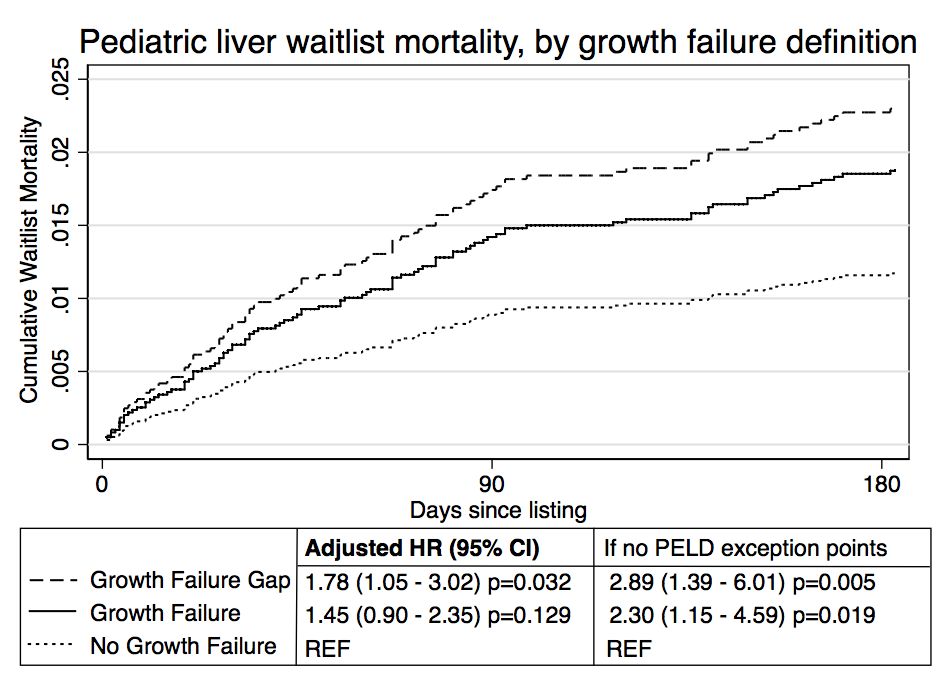Impact of the Pediatric End-Stage Liver Disease Growth Failure Threshold on Waitlist Mortality in Children Awaiting Liver Transplant
University of California, San Francisco, San Francisco, CA
Meeting: 2019 American Transplant Congress
Abstract number: D370
Keywords: Liver transplantation, Mortality, Pediatric, Waiting lists
Session Information
Session Name: Poster Session D: Late Breaking
Session Type: Poster Session
Date: Tuesday, June 4, 2019
Session Time: 6:00pm-7:00pm
 Presentation Time: 6:00pm-7:00pm
Presentation Time: 6:00pm-7:00pm
Location: Hall C & D
*Purpose: To examine the impact on waitlist mortality of Pediatric End-Stage Liver Disease (PELD)’s incorporation of growth failure (GF) as a threshold variable—present or absent based on weight and height z-score cutoffs that shift in 3-month age intervals, and thus do not correspond to a z-score of -2 for children of most ages.
*Methods: United Network for Organ Sharing (UNOS) Standard Transplant Analysis and Research (STAR) data analyzed on all U.S. candidates listed <12 years of age for primary liver transplant, excluding those listed as Status 1. Children were categorized as GF (weight or height z-score <-2 and below the PELD GF threshold for age and sex), GF Gap (weight or height z-score <-2 but both weight and height above the PELD threshold), or No GF (weight and height z-score ≥-2 and above PELD threshold). Mortality risk predictors identified with competing risks regression.
*Results: Of 3,291 children listed for liver transplant in 2003-2014, 26% were GF by z-score and PELD criteria, 17% fell in the GF Gap, and 57% had No GF. Children in the GF Gap were more likely to be <1 year of age (83%) than those with GF (46%) or no GF (44%, p<0.001). Children with GF and those in the GF Gap had higher calculated PELD at listing (median 15, 12 vs. 5 no GF, p<0.001) and were less likely to receive PELD exception points (57%, 56% vs. 64% no GF, p<0.001) than children with no GF.
Children in the GF Gap group had a significantly higher risk of waitlist mortality than those with no GF after adjusting for other significant predictors: age at listing, race/ethnicity, transplant indication, PELD score, being on life support and UNOS region (FIGURE). GF was associated with increased mortality risk in univariate analysis only.
Among children who were not granted any PELD exception points (n=1,291), being in the GF Gap or meeting GF by both z-score and PELD criteria both significantly increased waitlist mortality risk, after adjusting for transplant indication, PELD score, being on life support and UNOS region (FIGURE). For children who received exception points (n=2,000), neither GF nor GF Gap was a significant predictor of waitlist mortality (data not shown).
*Conclusions: PELD’s incorporation of GF as a binary variable leaves many children in a “growth failure gap,” in which they have weight or height z-scores <-2 but do not meet PELD criteria for GF. Being in the GF gap increases the risk of waitlist mortality. PELD should be revised to correct this disparity.
To cite this abstract in AMA style:
Swenson SM, Roberts JP, Rhee S, Perito ER. Impact of the Pediatric End-Stage Liver Disease Growth Failure Threshold on Waitlist Mortality in Children Awaiting Liver Transplant [abstract]. Am J Transplant. 2019; 19 (suppl 3). https://atcmeetingabstracts.com/abstract/impact-of-the-pediatric-end-stage-liver-disease-growth-failure-threshold-on-waitlist-mortality-in-children-awaiting-liver-transplant/. Accessed December 17, 2025.« Back to 2019 American Transplant Congress

